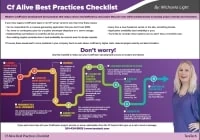Dominic Watson talks about “Marketing Automation using the Preside Platform”, in this episode of the ColdFusion Alive Podcast, with the host Michaela Light. Dominic is one of the speakers for the upcoming Into The Box ColdFusion Conference, where he will talk about Preside Platform Deep Dive.
“Preside has been around for a lot longer than it appears to have been around. It was at Pixelate. It was a commercial application that we licensed to all of our customers, but nobody else outside of Pixelate used it, but it competed on a lot of features for the other CMS's out there. We have a large number of medium, large-sized clients that were using it.” – Dominic Watson
Contents
- Show notes
- Why use a CMS?
- Why use an application platform?
- Why you need to be doing marketing automation in your business apps?
- ColdBox invisible framework
- Why are you proud to use CF?
- WWIT to make CF more alive this year?
- What are you looking forward to at Into The Box conference?
- Mentioned in this episode
- Listen to the Audio
- Bio
- Links
- Interview Transcript:
Show notes
Why use a CMS?
Why yet another CF CMS?
- Why they had shifted from closed source to open source.
- Problems with this shift
- How it's different from ContentBox and MuraCMS
- It is an application platform with CMS abilities
Why use an application platform?
- How to customize with Preside extensions?
- Better at customizing than other CMS
- Why Extensions are key
- Cascading inheritance and overriding core behavior
Why you need to be doing marketing automation in your business apps?
- Marketing filters for user behavior
- Email center – transactional emails, broadcast, marketing automation
- List segmentation
ColdBox invisible framework
- Task managing
Why are you proud to use CF?
WWIT to make CF more alive this year?
What are you looking forward to at Into The Box conference?
- Preside is CMS and custom app dev built on top of ColdBox
- Coding more responsibly
Mentioned in this episode
-
Preside
-
ContentBox
-
MuraCMS
-
State of the CF Union survey 2017, Q8 What CMS do you use
-
Marketing automation
-
Hubspot
-
Infusionsoft
Listen to the Audio
Bio
Dominic Watson
Dominic Watson trained as a Musical Theatre actor before embarking on a career in London's west end. Fortunately, this folly was cut short by an overtaking love of all things programming that led to a decisive career change building web applications.
Programming CFML for over 10 years, he is now the technical lead at Pixl8 Interactive, a London-based digital agency specializing in Web and Intranet development, and lead developer of Preside, our open source CFML CMS and application development platform.
Links
- Preside.org
- Slack channel presidecms.slack.com (free invite on Preside website)
Interview Transcript:
Michaela Light: Welcome back to the show. I’m here with Dominic Watson, the lead engineer of Preside at Pixelate Interactive. He is going to be talking about doing marketing automation using the Preside platform, which is a ColdFusion platform and CMS.
We’re going to look at some basic questions here, why you’d even want to use the CMS and not your own homegrown piece of code or not use one at all? And why yet another ColdFusion CMS had to be created, and why they shifted from closed source to open source and problems they had with that, how Preside is different from ContentBox and Mura CMS and other CMS’s and what exactly is an application platform, and how you can customize the Preside application platform with the extensions and cascading inheritance and overriding core behavior, and also why you should be doing marketing automation in your ColdFusion business apps.
Welcome Dominic.
Dominic Watson: Thank you.
Michaela Light: Yes, hello, joining us from England. Let’s start off with the big question in the room. Why should people use a CMS instead of just rolling their own code or not using one?
Dominic Watson: Sure. I’ll answer it, to start with, for us, we have a business that sells services, so we create sites for our clients. All of our clients require CMS. They are large organizations with multiple editors. They won’t have their own in-house teams so they need to be able to create content through tools that are easy to use and have all the features that you require for managing content.
I suppose if the question is aimed at, you’re an in-house team with a single application, why would you use a CMS? I would suppose, especially we’re talking about using Preside as a CMS, it’s around formalizing your processes around creating your content. Rather than doing it through code all the time and requiring that kind of expertise, you’re doing it … Being able to focus more editorially. Just very briefly, if we were to look at that with Preside, it marries very well with your technical abilities and the ability to do a little bit of code to then allow your editorial side of things to grow much better.
Michaela Light: Yeah, so it kind of abstracts out the content from the rest of the application.
Dominic Watson: Absolutely, yeah.
Michaela Light: I was kind of interested in the ColdFusion state of the union survey this year. The biggest CMS was homegrown.
Dominic Watson: Yeah.
Michaela Light: Which is a little surprising. Let me just share that on the screen for the folks who are watching on YouTube.
Dominic Watson: Yeah, I guess it’s surprising and it’s not, right?
Michaela Light: Yeah, 31% of people taking that survey have a homegrown CMS. Actually, the biggest winner on the CMS category is 41% of people who don’t even use a CMS.
And to continue learning how to make your ColdFusion apps more modern and alive, I encourage you to download our free ColdFusion Alive Best Practices Checklist.
Because… perhaps you are responsible for a mission-critical or revenue-generating CF application that you don’t trust 100%, where implementing new features is a painful ad-hoc process with slow turnaround even for simple requests.
What if you have no contingency plan for a sudden developer departure or a server outage? Perhaps every time a new freelancer works on your site, something breaks. Or your application availability, security, and reliability are poor.
And if you are depending on ColdFusion for your job, then you can’t afford to let your CF development methods die on the vine.
You’re making a high-stakes bet that everything is going to be OK using the same old app creation ways in that one language — forever.
All it would take is for your fellow CF developer to quit or for your CIO to decide to leave the (falsely) perceived sinking ship of CFML and you could lose everything—your project, your hard-won CF skills, and possibly even your job.
Luckily, there are a number of simple, logical steps you can take now to protect yourself from these obvious risks.
No Brainer ColdFusion Best Practices to Ensure You Thrive No Matter What Happens Next
ColdFusion Alive Best Practices Checklist
Modern ColdFusion development best practices that reduce stress, inefficiency, project lifecycle costs while simultaneously increasing project velocity and innovation.
√ Easily create a consistent server architecture across development, testing, and production
√ A modern test environment to prevent bugs from spreading
√ Automated continuous integration tools that work well with CF
√ A portable development environment baked into your codebase… for free!
Learn about these and many more strategies in our free ColdFusion Alive Best Practices Checklist.

Michaela Light is the host of the CF Alive Podcast and has interviewed more than 100 ColdFusion experts. In each interview, she asks "What Would It Take to make CF more alive this year?" The answers still inspire her to continue to write and interview new speakers.
Michaela has been programming in ColdFusion for more than 20 years. She founded TeraTech in 1989. The company specializes in ColdFusion application development, security and optimization. She has also founded the CFUnited Conference and runs the annual State of the CF Union Survey.

